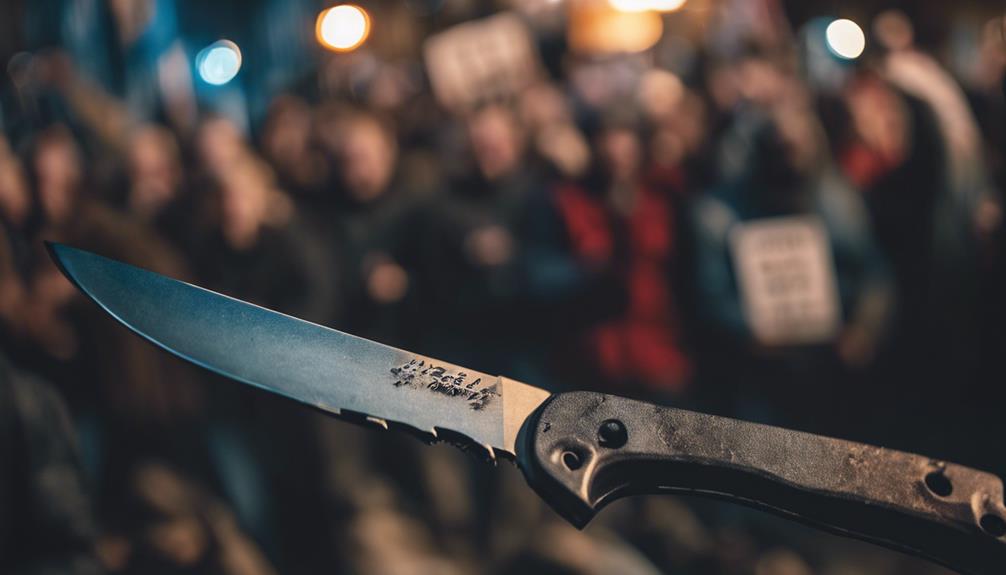Creating an affordable bug out bag is essential for your emergency preparedness. Start with a sturdy backpack or medium duffle from a thrift store. Pack high-calorie food like canned tuna, peanut butter, and a gallon of water per person daily. A lightweight camping stove and multi-tool can be found cheaply for cooking. Don't forget a survival knife, fire starters, and a flashlight for emergencies. Include a tarp or emergency blanket for shelter and basic hygiene supplies like soap and wipes. Your bag's effectiveness improves with regular checks on supplies, and you'll find even more practical tips to enhance your setup. To further enhance your bug out bag, consider adding essential prepping books to educate yourself on survival skills and emergency preparedness. Look for guides on foraging and wild edibles, first aid and medical care, and outdoor survival techniques. These resources can provide valuable knowledge and guidance in critical situations, helping you to be better prepared for any emergency. By incorporating these essential prepping books into your bug out bag, you can further increase your chances of survival and self-sufficiency in a crisis.
Key Takeaways
- Choose a medium-sized duffle bag or sturdy backpack with multiple compartments for organization and comfort.
- Stockpile high-calorie, non-perishable food items like canned tuna, spam, and peanut butter for sustenance.
- Include essential cooking tools such as a lightweight camping stove, sturdy pot, and multi-tool for efficient meal preparation.
- Prioritize basic survival gear like a survival knife, fire starters, and a flashlight for safety and functionality in emergencies.
- Add hygiene supplies, including soap, hand sanitizer, and portable toilet options, to maintain cleanliness and sanitation.
Choosing Your Bag Wisely

When it comes to choosing your bug out bag, think about functionality and comfort first.
You'll want a medium-sized duffle bag or a sturdy backpack that offers enough space without being cumbersome. Look for options with multiple compartments to keep your gear organized and easily accessible.
Thrift stores often have affordable choices, so don't hesitate to explore those. Regularly assess your bag's contents to verify everything remains relevant and useful.
Prioritize versatility; choose items that serve multiple functions to maximize space and efficiency.
Essential Food and Water

Choosing the right bag sets the stage for packing effectively, and one of the most important aspects of your bug out bag is food and water.
You'll want to stockpile affordable, high-calorie items that last long, like canned tuna and spam. Peanut butter is also a great choice, offering protein with a shelf life that won't let you down.
For hydration, aim for at least one gallon of water per person per day, and don't forget water purification tablets to guarantee your drinking water is safe.
Cooking Tools on a Budget

In an emergency, having reliable cooking tools can make all the difference, but you don't need to spend a fortune to equip your bug out bag.
Start with a lightweight camping stove, which you can often find at thrift stores or online marketplaces for around $20. A sturdy pot or pan is essential; look for used options that can withstand heat.
Don't forget a multi-tool, which serves as both a knife and a can opener—this can typically be found for under $15. A small cutting board and a set of reusable utensils are also budget-friendly additions.
With these affordable tools, you'll be ready to prepare meals efficiently, ensuring you stay nourished during any crisis.
Must-Have Survival Tools

Having reliable cooking tools sets the stage for survival, but you also need a solid selection of survival tools to handle various challenges.
For instance, mastering the art of bug out bags guarantees you're equipped with essential items for an emergency. A survival knife is vital; it's your go-to for cutting, slicing, and preparing food. Look for budget-friendly options around $14.
Fire starters, like BIC lighters, are important for warmth and cooking—don't overlook them! Multi-tools add versatility, allowing you to tackle various tasks without carrying multiple items; budget about $11 for a decent one.
Affordable Shelter Solutions

A sturdy tarp can transform your bug out bag into a reliable shelter solution without breaking the bank.
It's lightweight and versatile, allowing you to create a makeshift tent or cover from the elements. Pair it with an SOL emergency blanket for added warmth and insulation.
For a more durable option, consider a compact bivy sack, which offers excellent protection against moisture. You can often find these essentials at thrift stores or online marketplaces for budget-friendly prices.
Don't forget to pack some paracord or rope to secure your shelter effectively.
With these affordable items, you can guarantee a safe and comfortable place to rest, even in challenging conditions.
First Aid Kit Basics

Essential to any bug out bag, a well-stocked first aid kit can be a lifesaver in emergencies.
You'll want to include adhesive bandages for small cuts and scrapes, as well as antiseptic wipes to prevent infection. Pain relievers like ibuprofen are vital for managing discomfort, while gauze pads and medical tape help dress larger wounds.
Don't forget to add scissors and tweezers for easy access to splinters or other foreign objects. A thorough first aid kit can often be found for $8 to $10, making it an affordable essential.
Regularly check your kit to verify supplies are fresh and up-to-date. Being prepared with these basics can make a significant difference in emergency situations.
Cordage and Navigation Essentials

Including versatile cordage and reliable navigation tools in your bug out bag is essential for survival. A solid choice is 550 cord, which can be used for shelter, gear repair, or even fishing. Duct tape is another lifesaver for quick fixes. For navigation, a compass and printed maps are vital; they can guide you when technology fails. Familiarizing yourself with these tools can make a significant difference in high-stress situations.
| Cordage Type | Uses | Cost Estimate |
|---|---|---|
| 550 Cord | Sheltering, securing gear | $10 |
| Duct Tape | Repairs, first aid | $3 |
| Compass | Direction finding | $3 |
Mastering these essentials enhances your confidence and preparedness.
Communication Devices for Emergencies

After you've secured your cordage and navigation tools, it's time to focus on communication devices for emergencies. Staying connected can be essential during a crisis, so consider packing two-way radios.
They're reliable for short-range communication and don't rely on cellular networks. An emergency weather radio is also a smart choice, providing you with vital updates about storms and other threats.
Don't forget to establish a communication plan with family or friends, outlining where to meet or how to reach each other. Familiarize yourself with local emergency services and shelters, as they can offer support when needed.
These devices are affordable and can greatly enhance your safety during an emergency situation.
Hygiene Supplies for Preparedness

Maintaining personal hygiene during emergencies is crucial for your health and well-being. Stock up on basic hygiene supplies to keep yourself clean and comfortable. Include soap, hand sanitizer, and toothbrushes with toothpaste in your bug out bag.
Don't forget sanitary supplies like wipes, which can help in situations where water is scarce. Portable toilet options can also guarantee proper sanitation when facilities aren't available.
Trash bags are essential for waste disposal, keeping your area tidy and reducing health risks. Regularly check your hygiene items for expiration dates and replace them as needed.
Community Resources and Support

Community resources play an essential role in your preparedness journey, offering support and knowledge that can enhance your emergency planning. Engaging with local organizations and participating in workshops can build your skills, from first aid to food preservation.
You can also connect with prepper groups, where you can share ideas and trade supplies, creating a network of like-minded individuals. Consider joining community drills or training sessions to practice your skills in real-life scenarios.
These connections not only provide practical assistance but also foster a sense of belonging. When crises arise, a strong community can offer invaluable support, making your preparedness efforts more effective and resilient.
Don't underestimate the power of local resources; they can make a significant difference in your readiness.
Frequently Asked Questions
How Often Should I Update My Bug Out Bag Contents?
You should update your bug out bag contents regularly—at least every six months. Check for expiration dates, replace worn items, and guarantee everything's relevant to your current needs and circumstances. Stay prepared and ready!
What Are the Best Ways to Practice Survival Skills?
Imagine a sailor steering through stormy seas; you must practice survival skills regularly. Camp outdoors, build shelters, or start fires. Join local workshops, engage in community drills, and embrace challenges to strengthen your readiness and confidence.
How Can I Assess My Local Emergency Resources?
To assess your local emergency resources, research community services, join local preparedness groups, and attend emergency workshops. Connect with neighbors to share knowledge and establish communication plans for effective support during crises. Stay informed!
What Should I Include for Personal Safety in Emergencies?
In emergencies, you'll want personal safety gear that'll make you feel invincible! Include a sturdy knife, a reliable first aid kit, and a whistle. Trust me, you'll be ready to conquer anything that comes your way!
How Do I Create a Family Communication Plan?
To create a family communication plan, discuss meeting points, establish emergency contacts, and make certain everyone knows how to use communication devices. Practice your plan regularly, so everyone feels confident during emergencies.
Conclusion
By investing a little time and creativity, you can build a bug out bag that's both functional and budget-friendly. While others may spend a fortune on high-end gear, you'll find that thrift store gems and versatile essentials can make all the difference. In emergencies, it's not about what you spend, but how prepared you are. So, arm yourself with knowledge and resourcefulness—your peace of mind is worth more than any price tag. Get ready to face the unexpected!










